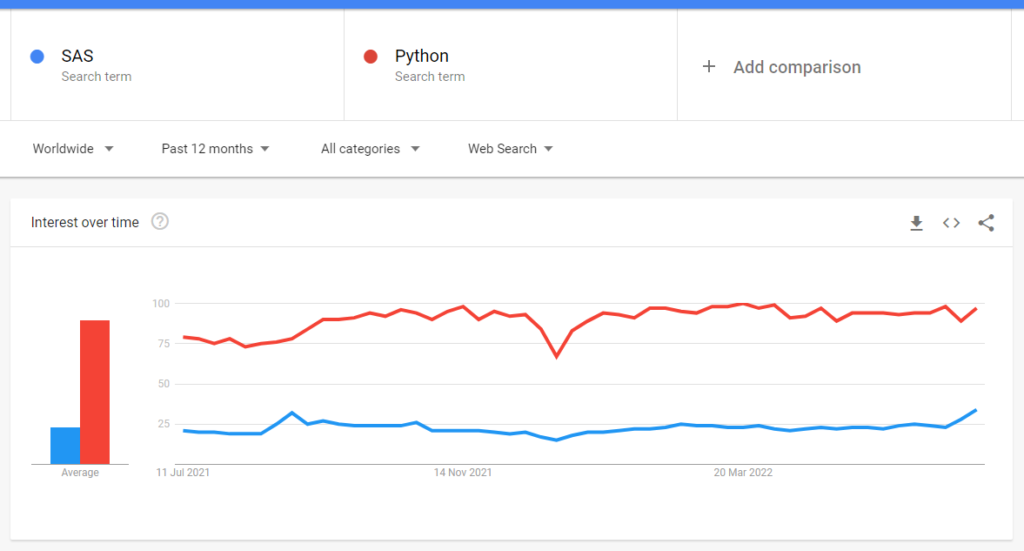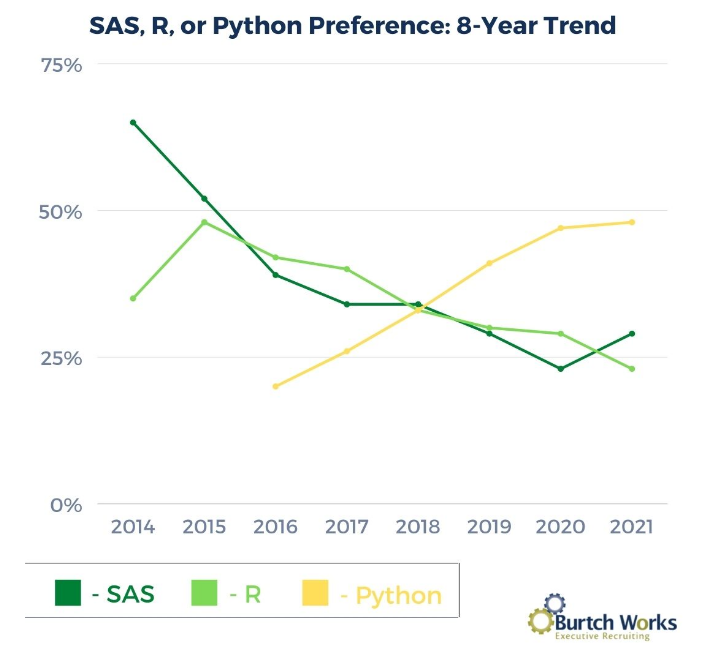Today’s rapidly changing and competitive world it is important to understand hot and trending technologies. In the analytics and data science field, the more commonly discussed topic is the difference between SAS, R, and Python. Which one is the best and why?
As demand for data analysis is growing rapidly, the demand for data analysts and data scientists are also going up. If you’re thinking about a career in data analytics then you should know at least one programming language to put one step inside the data analytics IT world.
Then the first question would be what are the options and which language to learn. This is the most popular question being asked by many people and guess what here you’ll get an in depth, descriptive answer to your question.
SAS vs Python: Google Trends

Why, SAS, R, or Python?
In the analytics industry SAS, R, and Python are the top choices you have. These are booming languages and widely used in the industry. Each language is different and has their pros and cons yet it serves the most common purpose in data analytics to provide insights based on available data.
Many big organizations are already using any of these programming languages for data analysis. They have set up tons of processes either using SAS, R, or Python and they’re heavily investing to set up even more complex processes.
Why use SAS for data science?
SAS is a statistical analysis software developed by SAS Institute for data management, advanced analytics, multivariate analysis, business intelligence, forecasting, and predictive analytics.
In SAS you can do advanced analytics and complex statistical operations. Due to its high reliability it is being used in large scale organizations and professionals. It is one of the favorite languages by data scientists to build models, and do data analysis.
Why use R for data science?
R is an open-source programming language that is widely used for data analysis, reporting, and graphing.
It allows the usage of several preprocessed packages that makes data wrangling a lot more easier. This is one of the main reasons as to why R is preferred in the Data Science community. R provides its famous ggplot2 package which is most famous for its visualizations.
The R programming language includes functions that support linear and non-linear modeling, classical statistics, classifications, clustering and much more.
Why use Python for data science?
Python is developed under an OSI-approved open source license, making it freely usable and distributable, even for commercial use.
It also has a huge and growing ecosystem with a variety of open-source packages and libraries. If you would like to download and install Python on your computer you can do it for free at python.org.
It is one of the best languages used by data scientists for various data science projects/applications. Python provides great functionality to deal with mathematics, statistics and scientific function.
Comparison Factors: SAS vs Python vs R
There has never been a conclusive answer when it comes to comparison between SAS, R, and Python. Why? Because the data world is very vast and it has numerous use cases. None of this technology provides a “perfect ALL-IN” solution that covers all your use cases.
It is always like for one use case SAS is better than Python whereas in other use cases Python maybe dominating so as R.
Your “requirement” is the only solution here to decide between SAS, R, and Python –What to choose! Further to give more clarity we’ve made comparisons among them based on important factors which are listed below.
- Easy of Learning
- Availability and Cost
- Data handling capabilities
- Data visualization
- Customer support and community
- Application advancement
- Deep learning
- Market demand
1. Easy of Learning
SAS is probably an easy and simple language to learn. It has a wide range of advanced tools with a rich user interface. Those who are familiar with the SQL can learn SAS even quicker though it is not preliminary. SAS documentation is also up-to-date and easy to understand.
R has the steepest learning curve among these. It is a low-level language, so naturally it requires writing lengthy codes even for simpler tasks.
Python is known for its simplicity and versatility. Anyone can learn Python. It’s a beginner friendly language though there are no widespread GUI interfaces as of now. The Python notebook is a good option with nice documentation.
When it comes to ease of learning, SAS is the easiest followed by Python, followed by R.
2. Availability and cost
SAS is a highly expensive commercial software. It is beyond the reach of individuals, or small or even medium sized companies to afford this. While there is a free cloud based SAS studio solution available for everyone with enough features to learn and get things going.
However, R and Python are open source free to use software. Anyone, small or big-scale organizations can use it and contribute to it.
R and Python have an advantage over SAS when it comes to cost-effectiveness.
3. Data Handling Capabilities
Over the period of time SAS has proved that they can handle huge data smoothly and perform operations stably.
R computes on memory (RAM) and it’s a biggest disadvantage though it has been removed now. With packages like plyr and Dplyr that make data handling much easier in R.
Python has libraries like Panda and NumPy that make data handling extremely easy.
In short, when it comes to data handling, it seems all three (Python, R, and SAS) perform very well with the huge data.
4. Data visualization
SAS can plot graphs but it’s merely functional. Though their new product SAS Viya seems to be promising.
R is one of the best tools for data visualization. It has packages like ggplot2, plotly, Rgis, etc.
Python has powerful graphical packages like VisPy and Matplotlib to create custom graphs easily.
Python and R are clearly winners here and dominate it when we talk about data visualization.
5. Customer Support and Community
This is an interesting aspect to look at it.
SAS has dedicated customer support for any kind of issues with the installation and usage. After all, why not, you pay a huge amount to use their software. But the downside of this due to its high cost is that they have a comparatively small community.
Whereas, R is open source, hence they don’t have customer support but they have got a large community from all over the world.
Python is also open source, and has no customer support. Since it is being used widely, they also have a large community.
6. Application advancement
All the three languages have basic and most required functions available. Since Python and R are open source it gets the latest features quicker but there is a possibility of error in those updates.
SAS releases their updates in a controlled environment with proper quality tests hence they have almost no errors. They roll out new major updates a few times a year.
7. Deep Learning
Without any doubt, deep learning is the future. Undoubtedly, Python is way ahead of R and SAS. You have got almost all the latest and trending packages to perform deep learning in real time.
The R is still trying to speed up the things when it comes to deep learning but SAS seems to be way behind both R and Python.
8. Market demand
SAS is the global leader in the available corporate jobs in data analytics. Most of the big organizations still work on SAS hence it has high demand for sas programmers.
Though it seems this scenario is slowly slowly getting changed, More and more companies are attracted towards open source software. That’s the reason there is great demand for R and Python skills.

Conclusion:
All three languages are in demand and have a bright future. As per your requirement you can decide what is best suits you and your goals.
Now we hope you have got a clear understanding of these three programming languages and believe this knowledge will be helpful to choose between SAS, R, and Python as your next career path.
Learn SAS Code (Free Course)
Learn SAS Code — The only SAS programming course available on the internet which you need to master Data Analytics, Business Intelligence (BI) and Cloud technology with tons of real life examples.
Unlock Free AccessFAQ
SAS “Statistical Analysis Software“, a statistical software suite is not open source software like other languages such as Python or R.
SAS is easiest language to learn followed by Python, followed by R. SAS has wide range of advanced tools with a rich user interface. People those who’re familiar with SQL can learn SAS even quicker though it is not a pre-requisite.
1 thought on “Comparison between SAS, R, and Python”
Comments are closed.